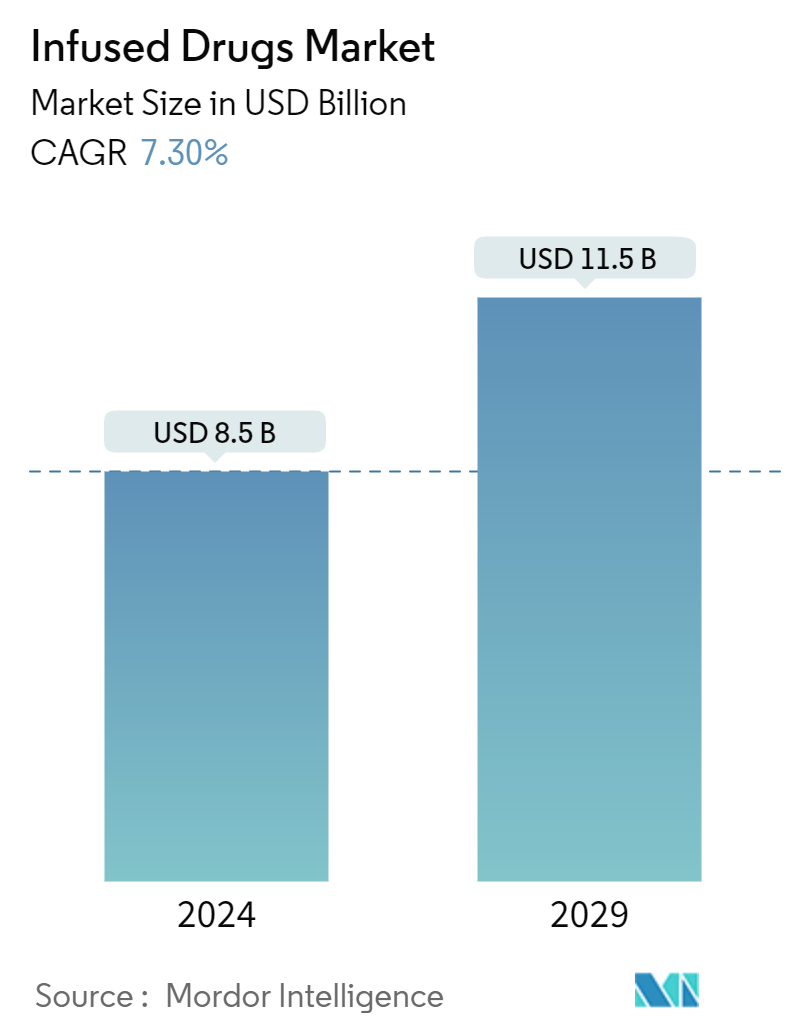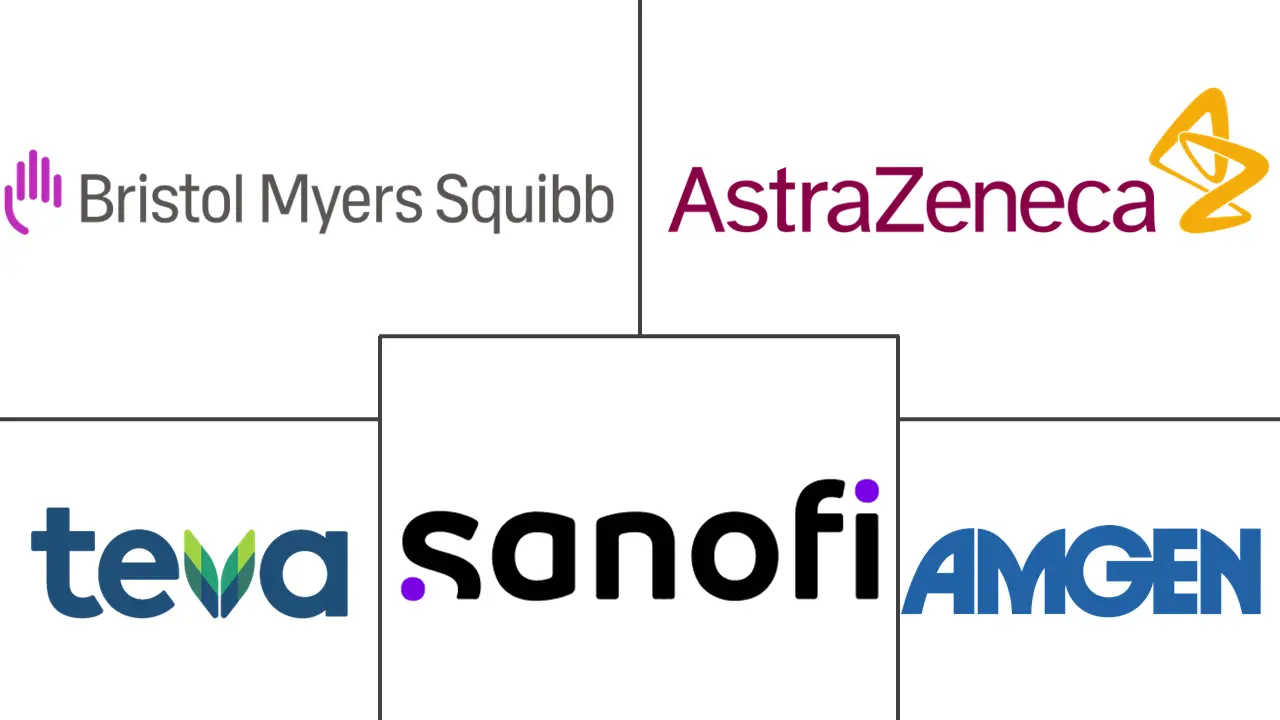Market Size of Infused Drugs Industry

| Study Period | 2019 - 2029 |
| Market Size (2024) | USD 8.5 Billion |
| Market Size (2029) | USD 11.5 Billion |
| CAGR (2024 - 2029) | 7.30 % |
| Fastest Growing Market | Asia Pacific |
| Largest Market | North America |
Major Players
*Disclaimer: Major Players sorted in no particular order |
Infused Drugs Market Analysis
The Infused Drugs Market size is estimated at USD 8.5 billion in 2024, and is expected to reach USD 11.5 billion by 2029, growing at a CAGR of 7.30% during the forecast period (2024-2029).
The key factors driving the growth of the infused drugs market are the growing prevalence of chronic diseases, advancements in drug delivery systems, and the rising geriatric population. For instance, in 2022, there were approximately 670 million people aged 60 years or older in Asia-Pacific, which accounted for roughly one in every seven people in the region. By 2050, the number is projected to be doubled to 1.3 billion. Among the elderly population in Asia, women comprise 54%, and this tends to increase with age due to their long life expectancy, according to a report by the United Nations Economic and Social Commission for Asia and the Pacific. The rising geriatric population is expected to drive the market over the forecast period.
- Moreover, the increasing prevalence of chronic conditions such as cardiovascular diseases, oncology diseases, and diabetes contribute to the market's growth. For instance, according to the report published by the British Heart Foundation (BHF) in April 2023, more than 7.6 million people were living with heart and circulatory diseases in the United Kingdom in 2022, which is further projected to increase with the aging population, decreasing fertility rates, and increasing survivability from other chronic diseases. Hence, the rising prevalence of chronic diseases is expected to increase the demand for infused drugs to effectively manage these diseases, ultimately driving the market studied market.
- Furthermore, increasing strategic activities such as acquisitions and product launches are also expected to drive the market. For instance, in March 2024, Bristol Myers Squibb received approval from the United States Food and Drug Administration for a biological product, Breyanzi, a CD19-directed chimeric antigen receptor (CAR) T cell therapy, for the treatment of adult patients with relapsed or refractory chronic lymphocytic leukemia (CLL). Breyanzi is delivered through a treatment process that culminates in a one-time infusion with a single dose containing CAR-positive viable T cells. Such product launches are expected to drive the market over the forecast period.
- However, the side effects associated with infusion drugs, strict regulations, and the high cost of manufacturing and developing infusion drugs may restrict the growth of the infused drugs market.
Infused Drugs Industry Segmentation
As per the scope of the report, IV infusion puts medicine, blood, or fluid directly into the bloodstream. This makes the treatment fast and powerful. The infused drugs market is segmented by drug, therapeutic area, and geography. By drug, the market is segmented into small molecules and biologics. In terms of therapeutic areas, the market is segmented into oncology, gastrointestinal diseases, rheumatoid arthritis, immune deficiencies, cardiology, neurology, diabetes, and other therapeutic areas. By geography, the market is segmented into North America, Europe, Asia-Pacific, Middle East and Africa, and South America. The market report also covers the estimated market sizes and trends for 17 countries across major regions globally. The report offers values in USD for the above segments.
| By Drug Type | |
| Small Molecules | |
| Biologics |
| By Therapeutic Area | |
| Oncology | |
| Gastrointestinal Diseases | |
| Rheumatoid Arthritis | |
| Immune Deficiencies | |
| Cardiology | |
| Neurology | |
| Diabetes | |
| Other Therapeutic Areas |
| By Geography | ||||||||
| ||||||||
| ||||||||
| ||||||||
| ||||||||
|
Infused Drugs Market Size Summary
The infused drugs market is poised for significant growth over the forecast period, driven by several key factors. The increasing prevalence of chronic diseases, such as cardiovascular conditions, oncology diseases, and diabetes, is a major contributor to this expansion. The market is also benefiting from advancements in drug delivery systems and the rising geriatric population, particularly in regions like Asia-Pacific, where the elderly demographic is rapidly increasing. Strategic activities, including product launches and acquisitions, are further propelling market growth. For instance, the approval of innovative therapies like Bristol Myers Squibb's Breyanzi and Eisai Co. Ltd's LEQEMBI highlights the ongoing advancements in infused drug treatments. However, challenges such as the high cost of manufacturing, strict regulations, and potential side effects of infusion drugs may pose constraints to market growth.
In North America, the infused drugs market is expected to experience robust growth due to the rising incidence of chronic diseases, particularly cancer, and substantial investments in research and development. The region's market is supported by strategic initiatives like product launches and collaborations among key players such as AstraZeneca, Sanofi SA, and Amgen, Inc. The increasing prevalence of cancer cases and the focus on developing novel infused therapies are driving demand in this region. Additionally, the market's competitive landscape is characterized by active participation from major pharmaceutical companies, which are leveraging strategies like mergers and partnerships to enhance their market presence. Overall, the infused drugs market is set to expand, driven by a combination of demographic trends, technological advancements, and strategic industry activities.
Infused Drugs Market Size - Table of Contents
-
1. MARKET DYNAMICS
-
1.1 Market Overview
-
1.2 Market Drivers
-
1.2.1 Increase in the Prevalence of Chronic Diseases
-
1.2.2 Increasing Geriatric Population
-
-
1.3 Market Restraints
-
1.3.1 Side Effects Associated with the Medications
-
-
1.4 Porter's Five Force Analysis
-
1.4.1 Threat of New Entrants
-
1.4.2 Bargaining Power of Buyers/Consumers
-
1.4.3 Bargaining Power of Suppliers
-
1.4.4 Threat of Substitute Products
-
1.4.5 Intensity of Competitive Rivalry
-
-
-
2. MARKET SEGMENTATION (Market Size by Value - USD)
-
2.1 By Drug Type
-
2.1.1 Small Molecules
-
2.1.2 Biologics
-
-
2.2 By Therapeutic Area
-
2.2.1 Oncology
-
2.2.2 Gastrointestinal Diseases
-
2.2.3 Rheumatoid Arthritis
-
2.2.4 Immune Deficiencies
-
2.2.5 Cardiology
-
2.2.6 Neurology
-
2.2.7 Diabetes
-
2.2.8 Other Therapeutic Areas
-
-
2.3 By Geography
-
2.3.1 North America
-
2.3.1.1 United States
-
2.3.1.2 Canada
-
2.3.1.3 Mexico
-
-
2.3.2 Europe
-
2.3.2.1 Germany
-
2.3.2.2 United Kingdom
-
2.3.2.3 France
-
2.3.2.4 Italy
-
2.3.2.5 Spain
-
2.3.2.6 Rest of Europe
-
-
2.3.3 Asia-Pacific
-
2.3.3.1 China
-
2.3.3.2 Japan
-
2.3.3.3 India
-
2.3.3.4 Australia
-
2.3.3.5 South Korea
-
2.3.3.6 Rest of Asia-Pacific
-
-
2.3.4 Middle East and Africa
-
2.3.4.1 GCC
-
2.3.4.2 South Africa
-
2.3.4.3 Rest of Middle East and Africa
-
-
2.3.5 South America
-
2.3.5.1 Brazil
-
2.3.5.2 Argentina
-
2.3.5.3 Rest of South America
-
-
-
Infused Drugs Market Size FAQs
How big is the Infused Drugs Market?
The Infused Drugs Market size is expected to reach USD 8.5 billion in 2024 and grow at a CAGR of 7.30% to reach USD 11.5 billion by 2029.
What is the current Infused Drugs Market size?
In 2024, the Infused Drugs Market size is expected to reach USD 8.5 billion.

